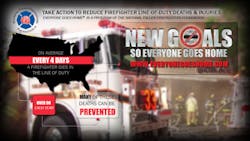When the term “thermal assault” was first discussed for Tampa 2, there were a few quizzical looks. Some wondered if this was the name of a new video game or action movie. To understand thermal assault, let’s look back a few years.
When I was a much younger firefighter, I learned that if my ears or the back of my neck felt like they were smoldering; if searing heat penetrated my gloved fingers when I touched a wall, furniture or a tool; or if my boots seemed to stick to the floor, it was time to leave the building. It was very simple, straightforward advice. Eventually we would notice scorched helmets and gloves, singed eyebrows, blistered ears or necks, and boots that had drooped and melted like wax. And that’s when we realized that we had been assaulted by the inferno and managed to survive.
In short, thermal assault refers to the stress that our bodies, gear and equipment endure at every fire. But the phrase goes further, too. Thermal assault challenges the outdated concept of over-aggressive firefighting. It questions the cost of taking a hoseline down a hallway, pushing further despite the scorching heat and diminishing air.
The reality is the research clearly shows that, in many circumstances, a quick knockdown from outside makes conditions inside better for victims and, in turn, safer for firefighters. Thermal assault is about using that research—along with our knowledge, experience, situational awareness and risk management skills—to do our jobs and keep firefighters safe. We need to recognize and anticipate every challenge and potential hazard during an incident rather than reacting to an urgent situation when it may be too late. Therefore, we need to do a better job of familiarizing ourselves with the growing body of evidence about fire behavior and dynamics.
Certain modifications—from engineered wood products and increased insulation in walls, in floors, and around windows and doors to the ubiquitous use of synthetic materials in our furnishings, fixtures and clothing—have drastically altered how fires ignite, expand and eventually are extinguished. As a result, the fire service asked manufacturers for alterations in turnout gear, breathing apparatus, masks and even electronic equipment to better protect our firefighters. The manufacturers obliged, making garments that could withstand infernos, breathing devices that would provide ample warning that we were almost out of air, and high-temperature cables for the microphones.
Our gear is far and away stronger and more reliable than it was when I first started fighting fires, and what we had then was a vast improvement on what the generation before used. But we must be mindful that this can be a double-edged sword.
Are there times when we push ourselves or our crew too far because we don’t feel the heat? Do we take into account that PPE that protects us from external heat also traps our body heat, propelling it back into us and further stressing our bodies? We must be cognizant of the limits of physics and extreme temperatures on all of our equipment, and our bodies, and consider whether the potential risks outweigh the benefits of our choices. At what point do we acknowledge that we have no business being in the kind of environment that no one can survive unless they have the proper equipment.
Likewise, consider the potential hazards resulting from synthetic fuels swirling around during an incident. It’s imperative that we place greater emphasis on and take more personal responsibility for thoroughly inspecting, cleaning, repairing, storing and eventually retiring our PPE and other devices. Not only will this help maintain the structural integrity, it can reduce our risk of exposure to toxins that can lead to cancer and other health issues.
We need to continue working with manufacturers and research bodies like NIST and UL to offer insights on essential issues. The more accurate data we have, the better prepared we are to respond. We must commit to using all the tools at our disposal, supporting ongoing research and then using the results if we want the safety and effectiveness of our fire service to improve. And we need to share these skills and techniques with the next generation of firefighters so that they can do their jobs effectively in this ever-changing environment.
Understanding thermal assault is not about undercutting rescues and not saving people. It’s about making sensible decisions for the best possible outcomes, all the while being cognizant of the beating that every fire has on our bodies and the long-term effects this has on our survivability.
About the Author

Ronald Siarnicki
National Fallen Firefighters Foundation
Fire Chief Ronald Jon Siarnicki began his career as a firefighter with the Prince George's County Fire/EMS Department in 1978 and with 24 years of fire, rescue, and emergency medical services operational experience, he has progressed through the ranks to Chief of the Department. In this position he served as the Chief Executive Officer responsible for the fire, rescue and emergency medical services of Prince George's County, Maryland. In July of 2001, Chief Siarnicki retired from the Prince George?s County Fire/EMS Department to take the position of Executive Director of the National Fallen Firefighters Foundation in July of 2001. He is a graduate of the Masters Program, School of Management and Technology, at the University of Maryland, University College, College Park, Maryland and has a Bachelor of Science Degree in Fire Science Management from UMUC. He is a certified Fire Officer IV, Fire Fighter Level III, and State Emergency Medical Technician. He has served as a UMUC faculty member for the Fire Science Curriculum since 1997.
